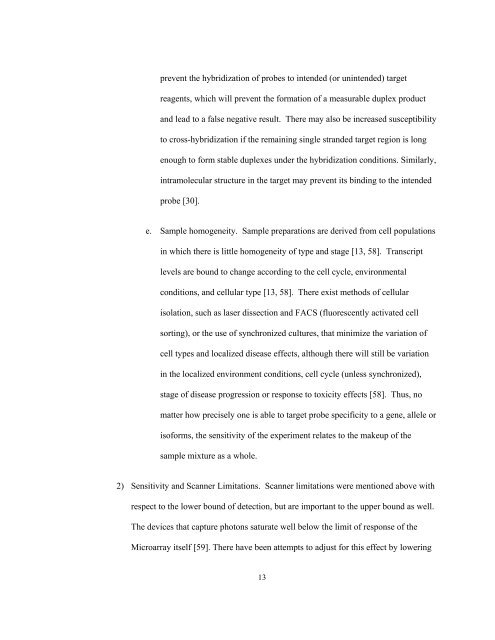Sample A: Cover Page of Thesis, Project, or Dissertation Proposal
Sample A: Cover Page of Thesis, Project, or Dissertation Proposal
Sample A: Cover Page of Thesis, Project, or Dissertation Proposal
You also want an ePaper? Increase the reach of your titles
YUMPU automatically turns print PDFs into web optimized ePapers that Google loves.
prevent the hybridization <strong>of</strong> probes to intended (<strong>or</strong> unintended) target<br />
reagents, which will prevent the f<strong>or</strong>mation <strong>of</strong> a measurable duplex product<br />
and lead to a false negative result. There may also be increased susceptibility<br />
to cross-hybridization if the remaining single stranded target region is long<br />
enough to f<strong>or</strong>m stable duplexes under the hybridization conditions. Similarly,<br />
intramolecular structure in the target may prevent its binding to the intended<br />
probe [30].<br />
e. <strong>Sample</strong> homogeneity. <strong>Sample</strong> preparations are derived from cell populations<br />
in which there is little homogeneity <strong>of</strong> type and stage [13, 58]. Transcript<br />
levels are bound to change acc<strong>or</strong>ding to the cell cycle, environmental<br />
conditions, and cellular type [13, 58]. There exist methods <strong>of</strong> cellular<br />
isolation, such as laser dissection and FACS (flu<strong>or</strong>escently activated cell<br />
s<strong>or</strong>ting), <strong>or</strong> the use <strong>of</strong> synchronized cultures, that minimize the variation <strong>of</strong><br />
cell types and localized disease effects, although there will still be variation<br />
in the localized environment conditions, cell cycle (unless synchronized),<br />
stage <strong>of</strong> disease progression <strong>or</strong> response to toxicity effects [58]. Thus, no<br />
matter how precisely one is able to target probe specificity to a gene, allele <strong>or</strong><br />
is<strong>of</strong><strong>or</strong>ms, the sensitivity <strong>of</strong> the experiment relates to the makeup <strong>of</strong> the<br />
sample mixture as a whole.<br />
2) Sensitivity and Scanner Limitations. Scanner limitations were mentioned above with<br />
respect to the lower bound <strong>of</strong> detection, but are imp<strong>or</strong>tant to the upper bound as well.<br />
The devices that capture photons saturate well below the limit <strong>of</strong> response <strong>of</strong> the<br />
Microarray itself [59]. There have been attempts to adjust f<strong>or</strong> this effect by lowering<br />
13




![[Sample B: Approval/Signature Sheet] - George Mason University](https://img.yumpu.com/21978828/1/190x245/sample-b-approval-signature-sheet-george-mason-university.jpg?quality=85)


![[Sample B: Approval/Signature Sheet] - George Mason University](https://img.yumpu.com/18694905/1/190x245/sample-b-approval-signature-sheet-george-mason-university.jpg?quality=85)






![[Sample B: Approval/Signature Sheet] - George Mason University](https://img.yumpu.com/18694552/1/189x260/sample-b-approval-signature-sheet-george-mason-university.jpg?quality=85)


![[Sample B: Approval/Signature Sheet] - George Mason University](https://img.yumpu.com/18694474/1/190x245/sample-b-approval-signature-sheet-george-mason-university.jpg?quality=85)